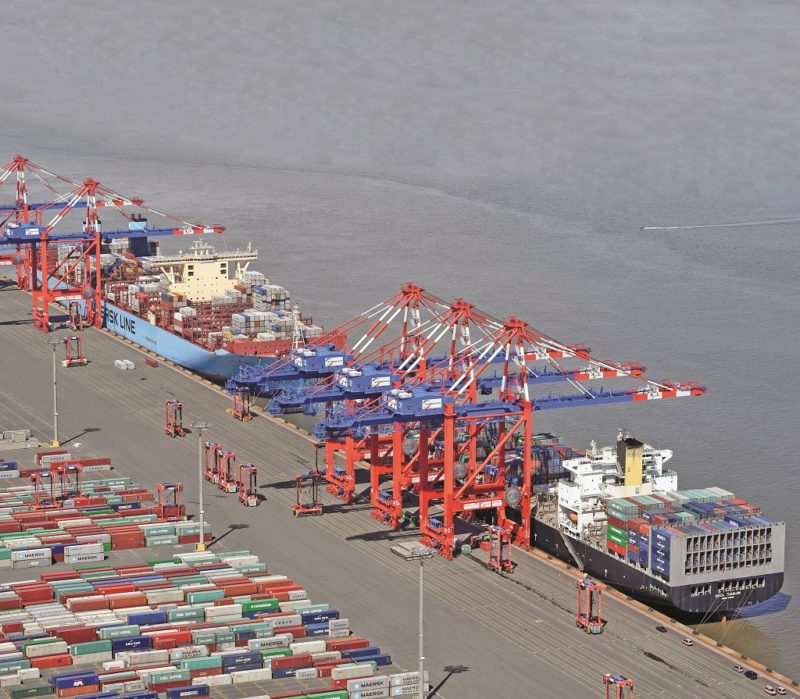
Today the German Navy, like its predecessors, calls Wilhelmshaven home. The massive naval base is home to a large proportion of the entire German fleet. What many may not realise, however, is that the majority of the facilities were built at the behest of Chancellor Adolf Hitler and utilised by the Nazi regime.
During World War Two Wilhelmshaven became one of the most heavily bombed ports in German held territory but throughout the conflict shipbuilding at the shipyards around the town continued producing such ships as the battleship Tirpitz, which Winston Churchill famously nicknamed ‘The Beast’.
Located 24 miles up the Jade River the development of Wilhelmshaven as a port was first visualised in the 1850s when Hafenbaudirektor (Chief of Port Construction) Wilhelm Goker announced plans for its construction. He had been following the instructions of the Prussian Prince Adalbert, who had decided the location of the Navy’s newest base. Construction of Wilhelmshaven and contemporary Kiel Naval Base was part of a major naval rearmament program in the mid 1850s. The first soil was turned in 1854 for a fortified shipyard. The work was carried out by an army of labourers using picks, shovels and wheelbarrows to move the massive amount of spoil. The working conditions for these men were extremely hard with malaria and water shortages in the summer and ice, snow and floods during the winter months. Sixteen years after work commenced the first parts of the naval base were operational in 1870. These consisted of a shipyard with two slipways and three dry docks, a 400 metre square harbour (Bau Hafen), a harbour canal (Hafen Kanal) and a 10 metre wide entrance to the sea.
King Wilhelm I officially opened the dockyard on 17th June 1869 and to honour the king the town of Heppens was renamed as Wilhelmshaven. In 1871 the new Kaiserliche Werft (Imperial Dockyard) was opened and construction of the first ship to be built at the shipyard, the 6,700 ton Grosser Kurfurst, was soon underway.
Soon the shipyard was extended with the addition of a fitting out harbour and a smaller harbour used by torpedo boats and smaller vessels. In 1886 the Ems-Jade Canal was finished as was a second, much larger 24 metre entrance lock. To link Kiel in the Baltic and Wilhelmshaven on the North Sea in 1887 construction of the impressive Kiel Canal began which was finally completed eight years later in 1895.
The next phase of expansion of the German fleet came between 1898 and 1900 following the passing of the fleet laws as proposed by Admiral Alfred von Tirpitz. A third entrance, still larger than the preceding two as 40 metres wide and 250 metres long was built and named after the admiral as the Tirpitz-Schleuse. Three commercial harbours were also put in hand. Three further dry docks, numbers 4 and 6 were added to North Quay and a floating dry dock was built locally to cope with demand for repair work.
During World War One Wilhelmshaven was crucial to German naval plans. Strategically located on the North Sea it became the focus of British blockades. Admiral Reinhard Scheer based 99 ships of the Hochseeflotte (High Seas Fleet) at Wilhelmshaven and they sailed from the naval base to do battle at Jutland, Dogger Bank and Heliogoland.
With German capitulation close in November 1918 the men onboard the warships mutinied whilst at anchor in the Jade. The mutiny spread ashore and within hours Wilhelmshaven had been seized and declared a socialist republic, it didn’t last long whilst in January 1919 a communist coup occurred which was put down by regular troops.
The shipyard was renamed after the war as Reichmarine-Werft (State Naval Dockyard) and built a handful of ferries and trawlers. The Weimar Republic in December 1921 ordered the heavy cruiser Emden. Further orders for torpedo boats followed before the yard received the order for another cruiser Konisberg in 1925. Construction of the pocket battleships Admiral Scheer and Admiral Graf Spee followed in 1931 and 1932 respectively. The following year saw Adolf Hitler assume power as Chancellor of Germany.
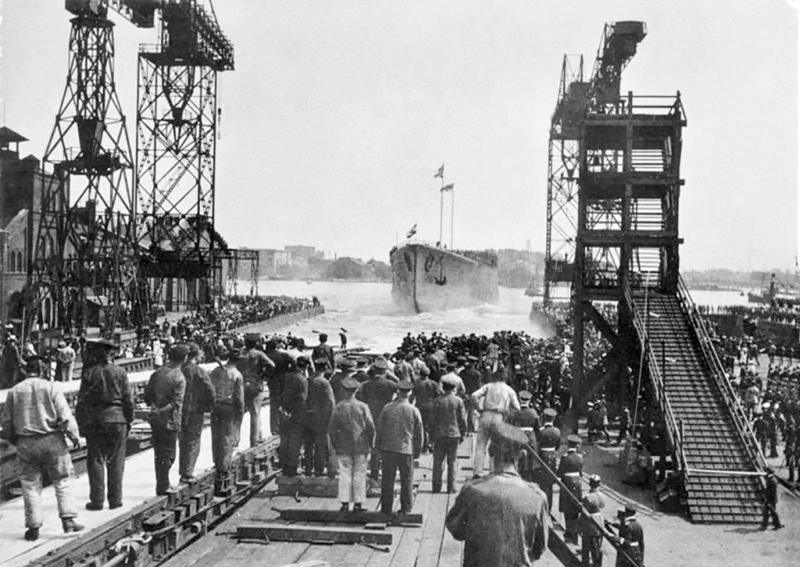
His ambitious plans for the Kreigsmarine would transform Wilhelmshaven almost completely. He placed orders for the construction of the 32,100 ton battlecruiser Scharnhorst armed with nine 11 inch guns. She was launched on 3rd October 1936 and commissioned on 7th January 1939. It would be the building of the 45,000 ton battleship Tirpitz that would mark the pinnacle of the Wilhelmshaven shipbuilding industry. Tirpitz was laid down on 2nd November 1936 and took two and a half years to build. Such large ships as Scharnhorst and Tirpitz required new shipbuilding facilities and new larger dock gates and these were progressively added to the complex including the 50 metre wide by 350 metre long Raeder-Schleuse which opened in 1942.
Hitler also approved construction of a brand new shipyard for the construction of his mammoth battleships the yard was given the name Nord-Hafen. Hitler had planned to build no fewer than six H class battleships with a displacement of 62,000 tons, to be followed by progressively heavier H41 class ships at 75,000 tons, the H42 class at 97,000 tons and the H43 class at 118,000 tons and finally Hitler’s super battleships of the H44 class weighing in at a colossal 139,000 tons. None of these ships were built but Wilhelmshaven undoubtedly would have shared in the fleets’ construction. What little work that had been done on the H class ships was cancelled on 10th October 1940 to divert steel and resources towards the U-boat campaign.
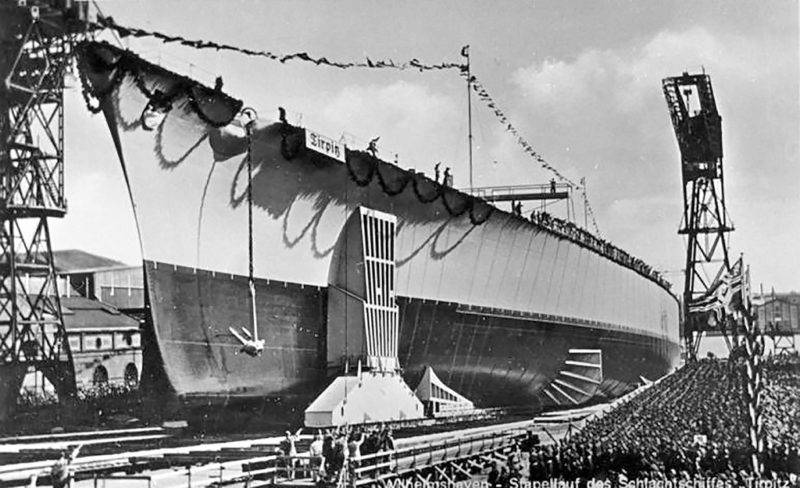
The U-Boat Campaign
The U-Boat campaign saw large numbers of submarines based at Wilhelmshaven and a new U-Boot-Stutzpunkt (U Boat Base) was built. The complex comprised of quays, barracks and a mess hall. Nine Type VII submarines U27-U35 soon transferred from Kiel in 1937. Wilhelmshaven also was homeport for a large number of destroyers, torpedo boats and sub chasers as well as the minelayers Cobra, Kaiser and Roland.
German U-Boats gained some notable early successes with Wilhelmshaven based boat U-29 sinking the aircraft carrier HMS Courageous and U-47 sinking the battleship HMS Royal Oak in Scapa Flow. Wilhelmshaven was a primary target for the British and on only the second day of the war, September 4, the Royal Air Force mounted a disastrous attack on the naval base. Fifteen Bleinhams from Nos 107, 110 and 139 Squadrons and twelve Hampden bombers from Nos 49 and 83 Squadrons and fourteen Wellingtons from Nos 9 and 149 Squadrons attacked Admiral Scheer, Gneisneau and Scharnhorst. Twenty one aircraft failed to find the target, another six turned back because of bad weather. Of the fourteen that reached their objective seven were lost. The German ships escaped virtually unscathed, with some bombs simply bouncing off the deck of Admiral Scheer. All the time the aircraft were being mauled by deadly accurate anti aircraft fire from the light cruiser Nurnberg and Leipzig and the destroyers Paul Jacobi and Diether Von Roeder. The most damage sustained was that of the cruiser Emden which lost 11 sailors and a further 30 wounded when bombs from a Bleinham which had broken up in the air exploded close to the ship.
Operation Weserbung
On 6th to 8th April 1940 Wilhelmshaven played a pivotal role in Operation Weserbung, the German invasion of Norway. Group 3 comprising of the light cruisers Konisberg and Koln, the artillery training ship Bremise, torpedo boats Wolf and Leopard, five motor torpedo boats and the transport ship Karl Peters slipped out of port at midnight on 8th April with 1,900 tons of stores onboard bound for Bergen.
Bomber Command over the course of the next two years would mount 17 major raids of Wilhelmshaven principally against the battleship Tirpitz, which was never damaged. Throughout the course of the war British and American bombers made 82 raids comprising of 5,668 sorties and dropped 19,048 tons of bombs on the port with the loss of 146 Allied airmen. Despite these statistics the naval base was never completely put out of action. The best result for the Allies being the sinking of the cruiser Koln on 30th March 1945 during a raid by 358 American bombers.

At the end of the war Wilhelmshaven surrendered without a fight to a battle group of the 1st Polish Armoured Division.

Demilitarisation
The Naval Base of Wilhelmshaven fell under British control in the post war era. Royal Navy plans called for the complete demilitarisation of the naval base and the warships therein. The aim was to remove any perceived threat and to demolish both Kiel and Wilhelmshaven completely. All remaining German surface ships, with the exception of the destroyer Z-39 and torpedo boat T-35, were assembled at Wilhelmshaven and were either scrapped, sunk or sent away as war repatriations including 30 U-boats under the terms of the Tripartite Naval and Merchant Marine agreements between the United Kingdom, United States of America and Russia.
The naval facilities were quickly removed with the plan being to create a commercial port in its place. A number of plans were drawn up with the easiest to implement being chosen. This plan saw the building of three dams and the blowing up of all facilities except those linking to the Ems-Jade canal. The deadline for this work to be completed was the middle of 1949. The work was undertaken by the Royal Engineers in what became known as Operation Bailiff. Three of the four harbour entrances were destroyed and the U-boat quay was removed. In fact contemporary photographs of the time show a barren wasteland devoid of buildings and facilities.
The West German Bundesmarine re-occupied Wilhelmshaven in the 1950’s. They excavated a new basin area and built new facilities. The complex is today known as the Marinearsenal and is home to the German fleet of anti submarine and air defence destroyers and frigates.
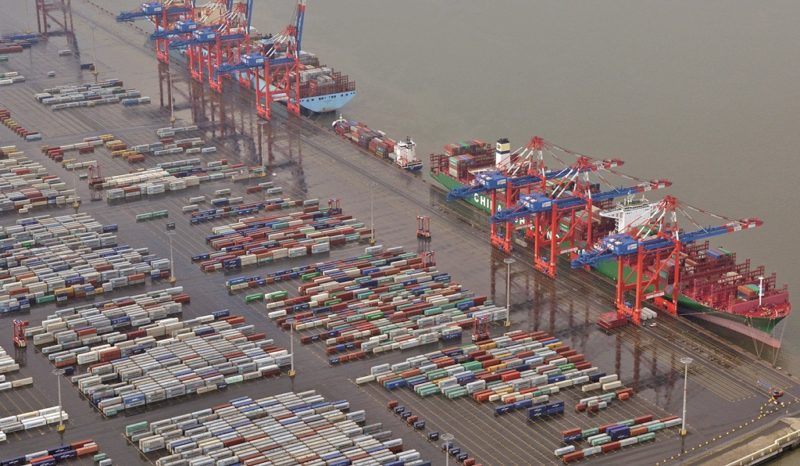
Wilhelmshaven today
Today the greatest concentration of commercial shipping activity in the Wilhelmshaven area is located at JadeWeserPort. This purpose built container port celebrated its first anniversary as recently as 21st September 2013. In fact its design, construction and operation are remarkable insofar as the concept was only floated as recently as 2001. The first soil was turned in March 2008, but as with most major infrastructure projects, legal delays dogged the process with the final handing over of the site and commissioning of the port taking place on 21st September 2012. In layout JadeWeserPort boasts 1,725 metres of quayside and has a capacity of 2.7million TEU per annum. The new port did not come cheap at a cost of €950 million, out of which €350 million was used for the construction of the port. Day to day operations at JadeWeserPort is undertaken by Eurogate.
The port was designed from the outset to be capable of handling the world’s largest container vessels of the time, up to and including 12,000 TEU at all tides. The site covers an area of 130 hectares, to which an additional future growth area of 400 acres could be added if required. The site boasts four berths and sixteen 1,800 tonne container cranes. These dominate the skyline rising to 125 metres with 69 metre jibs.
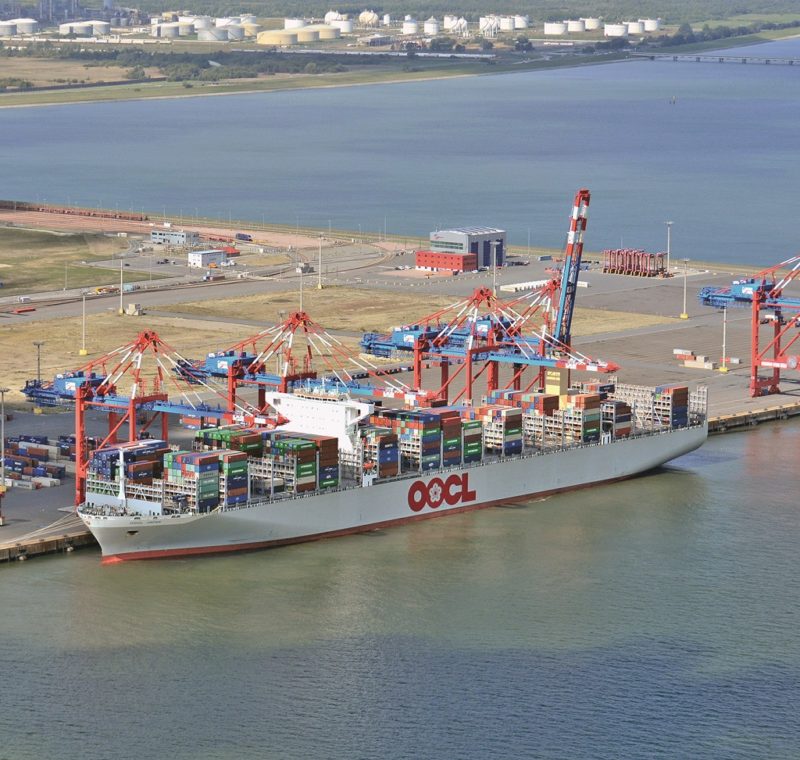
Building the port
The process of building JadeWeserPort was a major effort which started with the reclamation of 370 hectares of coastal land. 50,000 tonnes of steel, 80,000 m2 of concrete, 500,000 tons of bricks and 40 million m3 of sand were poured into the port, the work being carried out by a consortium company of Bunte, Josef Mobius Bau, Heinrich Hecker and Ludwig Voss. The Terminal buildings were designed by Angelis and Partner and Arup.
The all important railway link to the new facility was designed and built in four distinct phases. Interestingly during construction on the night of 10th October 2009 the dredger M30 was damaged when sucking sand from the seabed it pulled up a World War Two bomb.
In January 2011 the first phase of the port, a 1,000 metre long stretch of quay, was handed over to Eurogate. To service the tugs and other support vessels used at busy ports a special service port was created offering nine fixed berths and three alternate berths.
On 13th June 2012 the feeder vessel Pictor J became the first vessel to dock for trials at JadeWeserPort. The honour of being the first ‘official’ port visit was, however, made on 21st September 2012 by the container ship Maersk Laguna, but even this ship was beaten ‘unofficially’ by the fire damaged MSC Flamina and the Anna Schulte, which both entered port before the official launch.
JadeWeserPort attracted a wide range of clients including the fresh fruit company Nordfrost. Sadly the first year of operation utilisation of JadeWeserPort was much less than forecast resulting in putting 347 of the 400 strong workforce on short term contracts. Only 64,000 containers were slipped through the port in the first 12 months, just one tenth of the expected business level.
In September 2021 Hapag-Lloyd took a 30 per cent stake-holding in Container Terminal Wilhelmshaven and a 50 per cent stake in Rail Terminal Wilhelmshaven at JadeWeserPort.
Around the same time Germany’s only deep water port has also accepted the inward investment into infrastructure projects from several Chinese investors. In January 2022 Eurogate Container Terminal Wilhelmshaven announced that it intends to automate its container handling operations within the port. $169 million will be poured into the port over three years to make it one of the most modern automated ports in Europe.
The first automated berthing operation is expected sometime in 2024. The project has already seen the expansion of existing portside infrastructure projects including raising the existing eight container gantries and asphalting unsurfaced areas in the northern part of the terminal complex. A further two additional cranes are scheduled to arrive in 2023.
Wilhelmshaven is also at the forefront of developments as the world faces up to the Energy Crisis. Germany’s reliance on Russian gas and oil has been highlighted following the switching off of the gas pipeline following Russia’s invasion of the Ukraine. As a response to this Hydrogen company Tree Energy Solutions (TES) has accelerated its plans to develop the port into a world-scale hub for the importation of green gas and thus helping to secure Germany’s and Europe’s energy security.
According to TES green hydrogen will primarily be produced using solar, wind and hydro-electric in countries with abundant renewable energy sources, after which CO2 will be added to make green methane. This methane will then be shipped to new storage and processing facilities at Wilhelmshaven. At the port the green methane will be converted back into green hydrogen. The CO2 will be recaptured and shipped back to the countries of origin to ensure that none of this greenhouse gas escapes into the atmosphere. Wilhelmshaven expects that in the initial phase of the project 25 TWh per year of green gas will be imported allowing for the production of half a million tonnes of hydrogen. Once scaled up the facilities will be capable of producing five million tonnes of hydrogen or one tenth of Germany’s energy needs.

Wilhelmshaven and JadeWeserPort together are a major facility that is currently vastly underutilised, but there are plans for another port development at Innenjade as well as the refurbishment of the two ruined lock chambers of the former harbour entrance as dry docks for vessels up to 300 metres in length. Whatever the future holds JadeWeserPort is in the right location, with 18 metre high water and is capable of taking today’s largest vessels. Business will surely grow as the port is virtually brand new and yet to attract its proper share of the transhipment market.
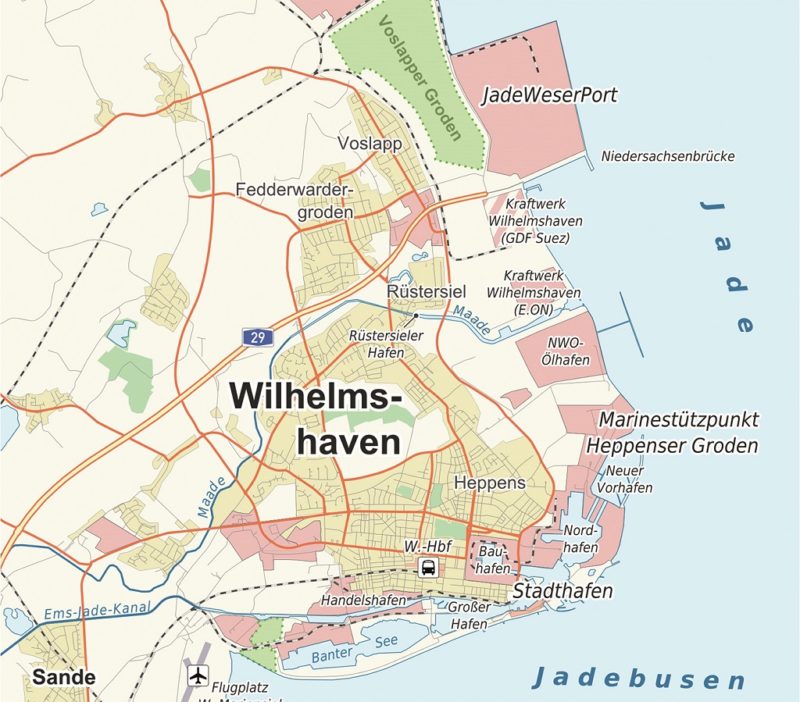
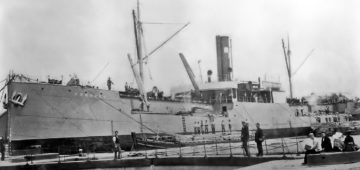



Comments
Sorry, comments are closed for this item